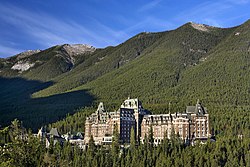Banff Springs Hotel
This article contains promotional content. (May 2016) |
| Fairmont Banff Springs Hotel | |
|---|---|
 | |
| Etymology | Nearby thermal springs |
| Location | 405 Spray Avenue, Banff National Park, Banff, Western Alberta, Alberta, Canada |
| Founded | 1887 |
| Founder | William Cornelius Van Horne |
| Built | 1888 (original hotel); 1928 (present hotel core) |
| Original use | Canadian railway hotel |
| Architect | Bruce Price (original hotel); Walter S. Painter (present hotel core) |
| Architectural style(s) | Canadian Chateau Style |
| Governing body | Fairmont Hotels and Resorts |
| Website | Fairmont Banff Springs Hotel |
The Banff Springs Hotel is a luxury hotel that was built during the 19th century as one of Canada's grand railway hotels, being constructed in Scottish Baronial style and located in Banff National Park, Alberta, Canada. The hotel was opened to the public on June 1, 1888.[1] Presently, The Fairmont Banff Springs resort hotel is owned by OMERS and operated by Fairmont Hotels and Resorts of Toronto. Banff Springs Hotel is situated at an altitude of 1414 m.[2]
The original building was designed by American architect Bruce Price.[3] It was built between spring 1887 and spring 1888 by the Canadian Pacific Railway at the instigation of its president, William Cornelius Van Horne.
The hotel is located within a spectacular setting in the Rocky Mountains, just above the Bow Falls, close to thermal springs. The main view from the hotel is across the valley and toward Mount Rundle, which frequently is cited in geology books for its exposed and tilted ancient seabeds. The hotel is within walking distance of the resort community of Banff.
Starting in 1911, a wholly new structure was built in stages to replace the 1888 hotel. Price's Shingle style-influenced wooden structure was replaced with a new building of concrete and faced with stone.[4] The new building was designed by another American architect, Walter S. Painter.
Halfway up the internal staircase closest to the Bow Falls is found a noted painting of William Davidson felling trees on the Miramichi River during colonial times. Davidson, who had grown up in Moray, close to Banff, Scotland, was the first European settler in that area of Canada. The name borne by the Canadian city and the national park is derived from his native country. The painting of the pioneer is by the war artist Cyrus Cunoe (1879–1916), who executed a series of paintings for the Canadian Pacific Railway.
History of renovations

The original building was quite different from the present Banff Springs structure. Variously termed a "Tudor hall" or a "Swiss chalet", the Price building was clad in shingles with stone accents, and featured a profusion of dormers, turrets, and roof lines. The 1888 structure cost $250,000 and a mistake made by the builder changed the intended orientation of the building, turning its back on the mountain vista. This building included more than 100 bedrooms, centered on a five-story, octagonal rotunda. An addition in 1902 expanded and renovated the building, adding more than 200 rooms. Further additions followed.[4]
By 1906, plans were advanced for a complete overhaul of the Banff Springs Hotel building, proposing a replacement of much of the original structure. Walter Painter, chief architect for Canadian Pacific Railway, designed an eleven-storey central tower in concrete and stone, flanked by two wings. This time correctly oriented to the dramatic view, the so-called "Painter Tower" was completed in 1914 at a cost of $2 million with 300 guest rooms and, for some time, became the tallest building in Canada. Construction of new wings was delayed by World War I and the surviving Price wings continued in service.
Further renovations were designed by architect, J. W. Orrock, who continued in the style originated by Painter, greatly expanded the Painter Tower, altering its roof line, and adding his own massive additions. In 1926, while work was proceeding on the new wings, a fire destroyed the remainder of the original building designed by Price.[4] The two new wings opened in 1928.
In 1968, the building was winterised and has been open year-round since that time.[5]
-
Front view of Banff Springs Hotel
-
Grand staircase in the main lobby
-
An interior staircase
-
Banff Springs Hotel Golf Course in 1966
-
George VI, king of Canada, and Queen Elizabeth with Prime Minister of Canada William Lyon Mackenzie King at the Banff Springs Hotel on May 27, 1939
See also
References
- ^ Fairmont Hotels and Resorts (February 2007). "History of the Fairmont Banff Springs". Archived from the original on 14 May 2007. Retrieved 2007-05-11.
{{cite web}}: Unknown parameter|deadurl=ignored (|url-status=suggested) (help) - ^ Banff Springs Hotel Altitude and Location
- ^ "Building a Dream in the Rockies at Banff". Banff Heritage Tourism.
- ^ a b c Barnes, Christine (1999). Great Lodges of the Canadian Rockies. Bend, Oregon: W.W. West. pp. 21–26. ISBN 0-9653924-2-2.
- ^ "Hotel History". Fairmont Banff Springs.
Further reading
- Banff Springs: The Story of a Hotel (2007; Summerthought Publishing)
- Rails & Rooms: A Timeless Canadian Journey (by Dave Preston; Whitecap Books)
External links
- Hotel buildings completed in 1888
- Hotel buildings completed in 1928
- Buildings and structures in Banff, Alberta
- Fairmont Hotels and Resorts
- Canadian Pacific Railway hotels
- Hotels in Alberta
- National Historic Sites in Alberta
- Scottish baronial architecture in Canada
- Hotels on the National Historic Sites of Canada register
- 1888 establishments in Canada





